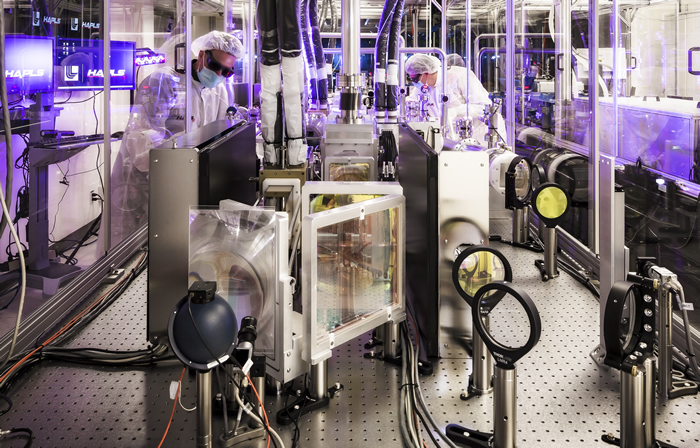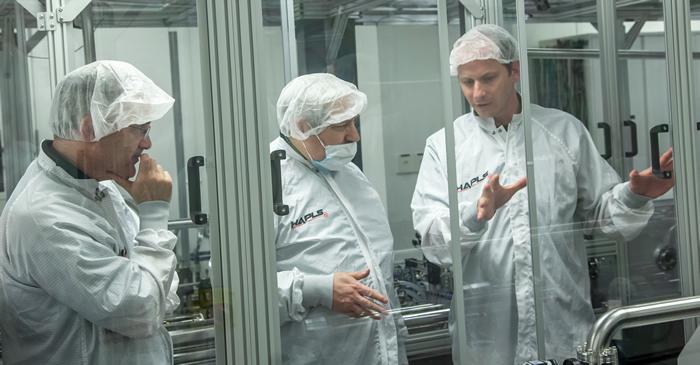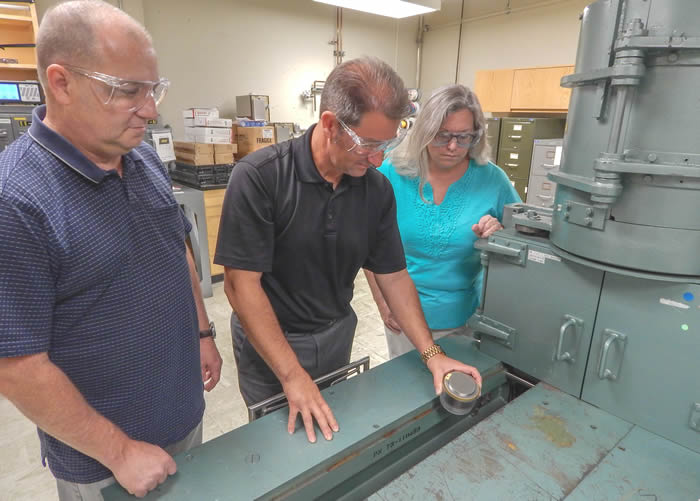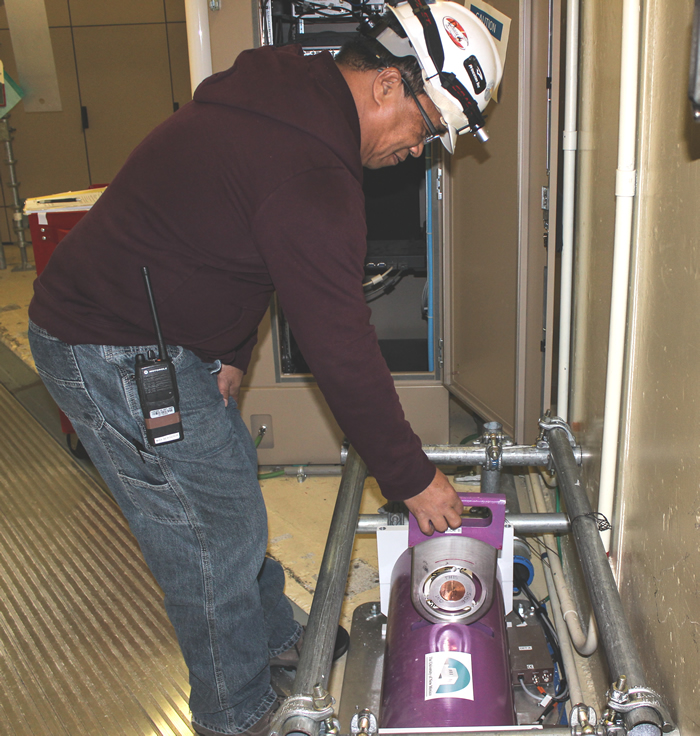Science & Technology - 2015
May
Supplying the ‘Life-Blood’ of Science
HAPLS Team Reaches Key Milestone
The LLNL team constructing the High Repetition Rate Advanced Petawatt Laser System (HAPLS) attained a major project milestone last month with the completion of assembly and alignment of key subsystems of the HAPLS pump laser system.

The team submitted a 100-page report documenting the required work on April 29, and the project’s Czech sponsors accepted it the next day. The pump laser is a main component of the HAPLS system, which when completed will be the world’s highest average power petawatt laser system. HAPLS is being designed, developed, assembled and tested at LLNL for delivery to the European Union’s Extreme Light Infrastructure Beamlines (ELI-Beamlines) facility in the Czech Republic.
 Jeff Jarboe (left) and Andy Bayramian check alignment on the diode delivery system on the HAPLS pump laser power amplifier. (Credit: Damien Jemison)
Jeff Jarboe (left) and Andy Bayramian check alignment on the diode delivery system on the HAPLS pump laser power amplifier. (Credit: Damien Jemison) HAPLS’ diode-pumped, solid-state pump laser delivers 200 joules of energy at a repetition rate of 10 pulses per second for an average power of two kilowatts. At the pump laser output, a frequency converter doubles the laser frequency from infrared to green which is used to pump a solid-state, short-pulse laser. The final amplifier and pulse compressor will convert the energy from the pump laser to 30-joule, 30-femtosecond (30 quadrillionths of a second) pulses for a peak power exceeding one petawatt (one quadrillion, or 1015, watts).
The pump laser features the world’s highest peak power laser diode arrays, representing a total peak power of 3.2 megawatts (see “Highest-power Laser Diode Arrays Commissioned”). The diode arrays are driven by a new type of pulsed-power system, developed by LLNL, which supplies the arrays with electrical power by drawing energy from the grid and converting it to extremely high-current, precisely-shaped electrical pulses.
HAPLS’ high repetition rate will be a major advancement over current petawatt systems. The ELI project is designed to explore fundamental physics under extreme conditions and will enable many applications in physics, medicine, biology, and materials science.
 HAPLS Program Director Constantin Haefner (right) briefs NIF & Photon Science Principal Associate Director Jeff Wisoff (left) and LLNL Director Bill Goldstein on the project’s progress during a May 8 tour of the facility. (Credit: Clayton Dahlen)
HAPLS Program Director Constantin Haefner (right) briefs NIF & Photon Science Principal Associate Director Jeff Wisoff (left) and LLNL Director Bill Goldstein on the project’s progress during a May 8 tour of the facility. (Credit: Clayton Dahlen) Supplying the ‘Life-Blood’ of Science
Located one-and-a-half floors underground in LLNL's Bldg. 151, the Nuclear Counting Facility (NCF) leverages its well-shielded, low-background environment to accurately measure nuclear materials for NIF and a variety of other Laboratory programs.
The NCF has been providing high-sensitivity radiation measurements since the inception of radiochemical diagnostics in support of the U.S. Nuclear Test Program. Managed by Phil Torretto and staffed by Todd Wooddy, Pete Nunes and Michaele Kashgarian, the NCF provides critical data necessary for a diverse set of programs at the Laboratory so that they can carry out their scientific and programmatic missions.
 Nuclear Counting Facility staffers (from left) Todd Wooddy, Phil Torretto, and Michaele Kashgarian place a NIF diagnostic sample in a sample changer for gamma-ray analysis. (Credit: Julie Russell)
Nuclear Counting Facility staffers (from left) Todd Wooddy, Phil Torretto, and Michaele Kashgarian place a NIF diagnostic sample in a sample changer for gamma-ray analysis. (Credit: Julie Russell) “I like to think of data as the ‘life-blood’ of science,” Torretto said. “And I think what gives me the most pride is that the NCF plays an integral role in providing that ‘life-blood’ to the scientists here at LLNL.”
The NCF supports applications in basic nuclear science, stockpile stewardship, nuclear safeguards and nonproliferation, nuclear forensics and counterterrorism, consequence management, emergency response, and environmental monitoring.
NIF, one of the NCF’s largest customers, sends post-shot samples from several diagnostics—the Radiochemical Analysis of Gaseous Samples (RAGS) system, the Neutron Activation Diagnostic (NAD), and the Solid Radiochemical Collection Diagnostic (SRC)—to the NCF for counting.
The RAGS diagnostic is a cryogenic system designed to collect the gaseous debris from the NIF Target Chamber after a laser shot, then concentrate, purify and analyze the debris for radioactive gas products. Radiation detectors on the RAGS apparatus produce rapid, real-time measurements of the radioactivity content of the gas. Based on the results of the counting, the total number of radioactive atoms that were produced via nuclear reactions during a NIF shot can be determined. After the gas is collected, a sample is then brought over to the NCF for additional counting to determine collection efficiency and number of atoms produced.
“Our group uses the NCF primarily for analysis of solid and gaseous debris samples collected following (NIF) shots,” said radiochemist and RAGS principal investigator Dawn Shaughnessy. “Debris is collected and then counted in order to determine parameters such as fuel areal density, mix between interfaces, cross-sections, and fission yields.”
The NAD measures the integrated neutron yield of a target capsule by activating a sample material, removing it from the Target Chamber, and determining the activation level using nuclear counting techniques. Specialized gamma-counting capabilities are required to analyze the material, making the NCF’s unique, highly-calibrated gamma-counting systems the perfect fit.
“They measure the activity induced in the sample by NIF neutrons to within 3 percent, which allows other neutron diagnostics to be calibrated against this value on every shot,” said Charles Yeamans, responsible scientist for NIF neutron activation diagnostics.
 Target Area Operator Max Bergonia inserts a copper Neutron Activation Diagnostic into a counter following a high-neutron-yield NIF shot. (Credit: Juan Soto)
Target Area Operator Max Bergonia inserts a copper Neutron Activation Diagnostic into a counter following a high-neutron-yield NIF shot. (Credit: Juan Soto) During a NIF shot, bulk target materials, as well as trace elements in targets, can be activated by neutrons or possibly even charged particles to produce radioactive species. SRC collection plates are placed 50 centimeters from the target to collect the solid debris created by the implosion, which may contain some of these radioactive species. The SRC plates are removed post-shot, and the presence of radioactive isotopes is determined by the NCF.
While these diagnostics send a prolific amount of samples to the NCF for gamma-ray analysis, the facility also supports work in a variety of other important areas.
“The Nuclear Counting Facility is the workhorse for analyzing radioactive samples that are generated for a variety of projects,” Shaughnessy said. “We also rely on the NCF for nuclear forensic samples, either real interdicted materials that are analyzed, or production and evaluation of synthetic debris used to exercise the nuclear forensics community. We send many samples there per month and rely on the extremely well-characterized detectors to provide us high-quality data that is used for a wide variety of mission support.”
Torretto added that through LLNL’s Consequence Management program, the NCF played a crucial role in the Department of Energy’s response to the reactor accident at Fukushima in April-May 2011.
“In a six-week period, NCF was called upon to perform detailed gamma-ray analyses on over 700 samples collected from areas affected by the Fukushima disaster in Japan,” he said.




